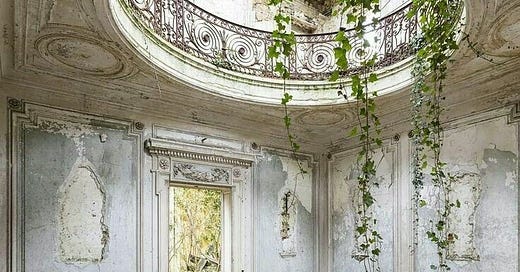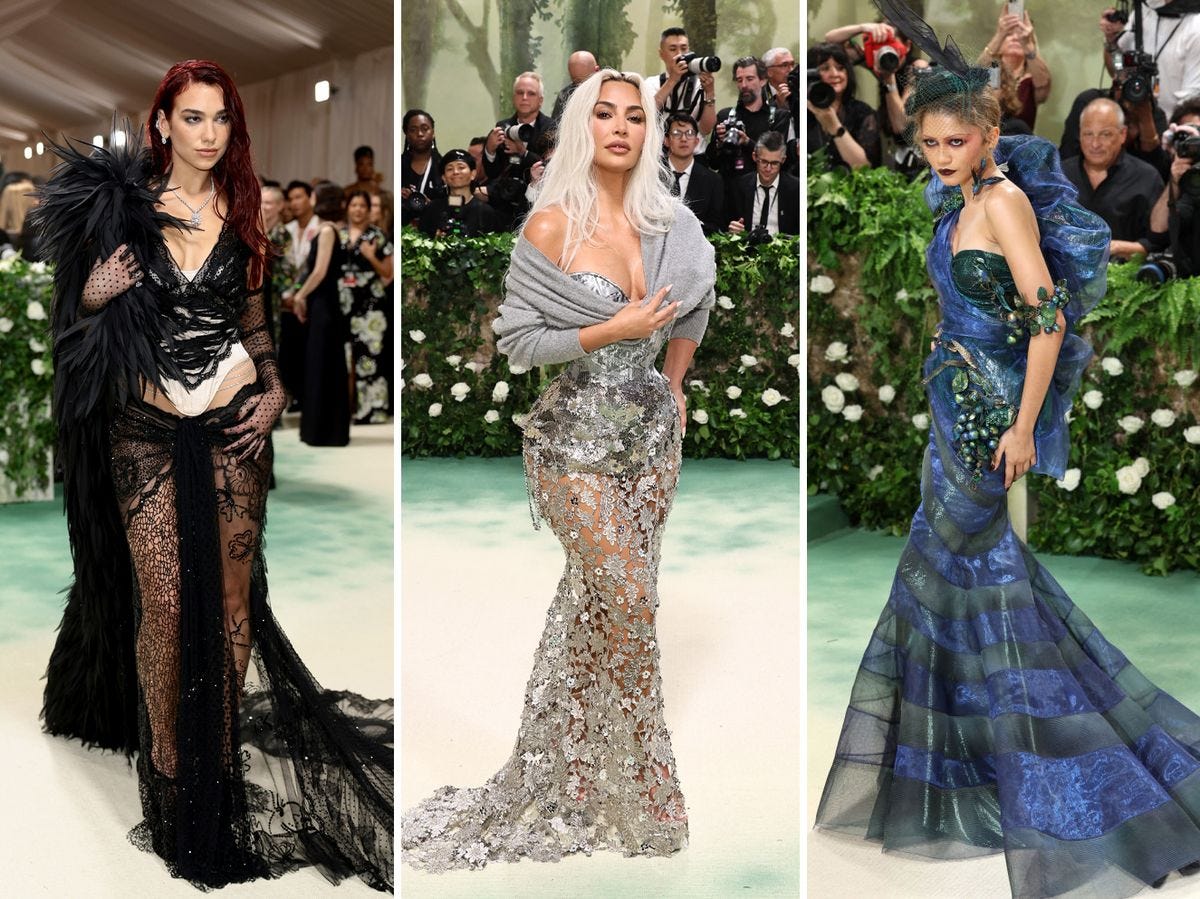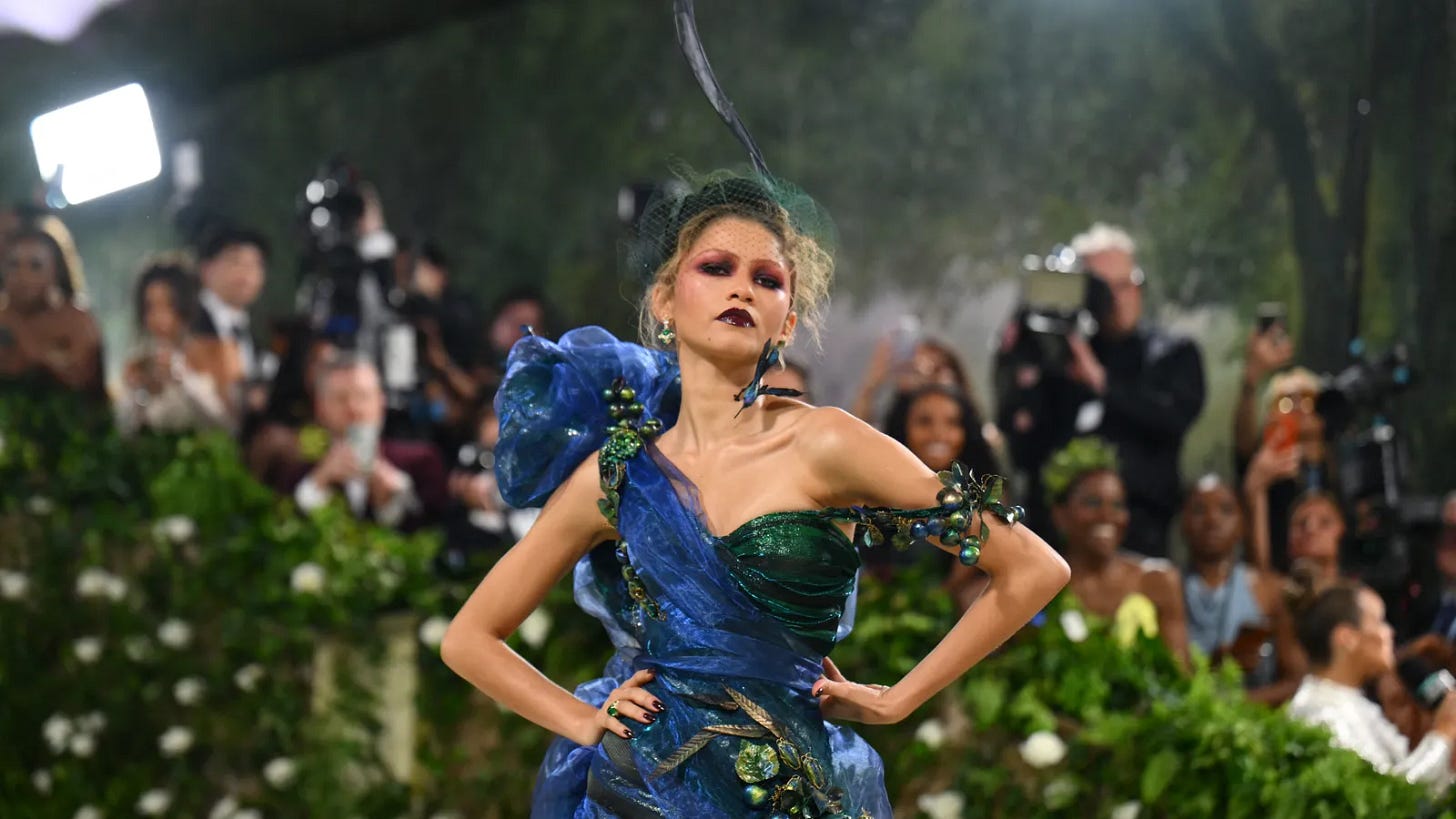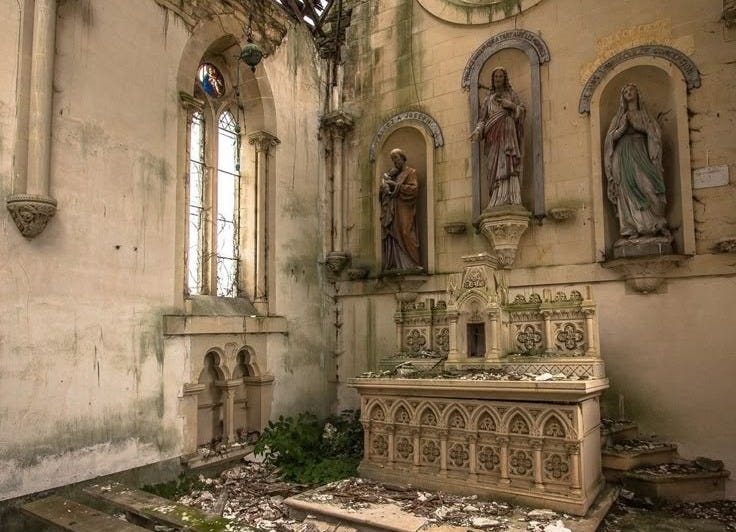A Tale of Decadence and Decline
A meditation on the fragility of privilege and the futility of resisting societal upheaval, The Garden of Time by J. G. Ballard was fittingly selected as the hauntingly allegorical theme of the 2024 Met Gala. Decadence and luxury encircled by walls, while a horde encroaches. Celebrities flaunting their cumbersomely opulent fashions while rightfully indignant protestors surround the Met. Inside, the evening stretches in a slow parade of splendour on borrowed time, while outside, the tide of humanity presses close. The culture industry, through the spectacle it creates, generates an illusionary reality masking widespread societal decay. Aristocratic habitus shields the privileged from awareness of their disconnect as they wield spectacle as a tool of distraction, however, if the tale ends prophetically, their time is running out.
Ballard’s story depicts the count and his wife in the last days of their time within their grand villa. Living in an isolation, insulated from any stains on their regal existence, their aristocratic habitus radiates in every graceful movement and refined taste. The count strolls the grounds accompanied by the sounds of his wife’s rendition of Mozart on the harpsichord. Pierre Bourdieu describes the body as “the most indisputable materialisation of class taste” (Bourdieu 2002). The count with his “imperious figure” cool and emotionless while Mozart flows “from his wife’s graceful hands” sets a tone of ceremonial grace and undeniable class (Ballard 2014) . The celebrities in attendance imitate this air of refinement, moving slowly and taking care to never look excited or truly happy. Striking pose after pose with marked indifference. Afterall, “‘good taste’ is displayed without ostentation, or rather with a ‘restraint’ which expresses respect for the forms of polite sociability” (Bourdieu 2002). Through a lack of self awareness, a common characteristic of elite habitus, most attendees seem to understand the theme at a surface level; they see garden in the name and wear vines or flowers. Little do they know, the theme permeates the very structure of their lives and that of the spectacle they are a part of.
As the Count and his Countess enact the daily rituals of their idyllic life, there is a looming horde of “labouring humanity” pressing towards their mansion (Ballard 2014). Paralleling the tale, outside of the gala, there are protests taking place to draw attention to the ongoing genocide in Gaza. Israel has recently invaded Rafah, the last remaining designated safe city. Videos emerge on social media highlighting the stark contrast of realities. Zendaya seductively poses in her Maison Margiela gown; bombs go off in Gaza. Kim Kardashian takes tiny sips of air in her suffocating corset, she calls it “an art form”; children trapped beneath rubble inhale mouthfuls of dust (Wickman 2024).
The Count and Countess have a powerful tool in their hands to stave off the masses approaching, in their garden grows crystal flowers. Once plucked, these flowers temporarily turn back time, postponing the impending doom. The Culture Industry serves a similar function for the elites, generating endless spectacle as distraction from worsening life conditions. Social decay is shrouded behind a facade of beauty. Viewers already drained from their alienating work turn to entertainment as escape, a way to mindlessly indulge (Adorno and Horkheimer, 137). Passive engagement is reinforced, rather than questioning and unrest. This is especially true when spectators feel as though they are active participants in the display. Viewers of the gala relish in their critique of each look presented by the detached celebrities. However, “what connoisseurs discuss as good or bad points serve only to perpetuate the semblance of competition and range of choice” (Adorno 1997). While the illusion of choice within this participation lulls spectators, entrancing them in the dizzying displays, it is as if time outside halts and existence is confined to this spectacular reality.
In its dazzling display, the Met Gala is a manifestation of what Guy Debord describes as the spectacle - a social order in which images and illusions triumph over direct experience. “The spectacle is not a collection of images, but a social relation among people, mediated by images” (Debord 2005). The gala serves as a framework through which each person understands their role in the social order. The media conglomerates control the narrative, using celebrities as sacrifice, as the Count does with the flowers in his garden. The celebrities seem to understand their role, as many come dressed not as the Count or Countess, but rather as the garden itself, covered head to toe in the flowers they represent. The audience is made to understand that they are uninvited guests, allowed to partake in a fantasy as outsiders at the cost of surrendering their own lives for a manufactured, vicarious existence that serves to maintain systems of domination. This powerful system of societal control is a self portrait of elite power which glorifies the structures that uphold its privilege. “The spectacle is the existing order’s uninterrupted discourse about itself, its laudatory monologue” (Debord 2005). Spectators are made privy, for a day, to the exclusionary world of elites, imbuing spectators with the faulty conviction that they themselves are participants. They revel in this spectacle, seduced by the glamour into voyeuristic participation that ultimately distracts from what the display conceals. As the flowers in the marvellous garden protect the Count and Countess’ isolated rest, “the spectacle is the bad dream of a modern society in chains and ultimately expresses nothing more than its wish for sleep. The spectacle is the guardian of that sleep” (Debord 2005). While in this spectacle induced slumber, seemingly distant threats may be ignored, postponed indefinitely, in favour of vicarious involvement in the world of elites.
This perceived proximity to celebrity is doubly dangerous, while offering the illusion of participation and escape into fantasy, the spectacle also defines what is worthy of observance. The spectacle “says nothing more than ‘that which appears is good, that which is good appears’” (Debord 2005). In this way, the spectacle asserts that what they see (celebrity, fashion, wealth) is the ultimate ideal to strive for. What about that which is not allowed to appear? Befitting aristocratic ignorance, the goal of the mob in Ballard’s tale is never considered. It is seen as nothing more than a threat to the aristocrats’ incontrovertible entitlement to luxury, an entitlement key to elite habitus (Bourdieu 2002). In sharp contrast to the elegance of the Count and Countess, the horde is described as ragged and disorganised, “amorphous and uncoordinated” (Ballard 2014). The culture industry's tone parallels Ballard’s. “Pro-Palestine activists cause chaos as they descend on the Met Gala” reads a headline (Sky News 2024). As the mob descends upon the mansion of the Count, protestors descend upon the gala. Why the protestors feel a visceral need to be screaming for the world to hear is never mentioned. Ironically, the newscaster smugly states “pro-Palestine activists couldn’t help themselves but cause a scene and make it about themselves” (Sky News 2024). The narrative is spun, projecting the narcissistic impulse of the spectacular gala onto protestors actively advocating for the lives of others. It is not those valiantly parading their wealth, beauty and power who make it about themselves, but rather those who demand better for humanity. Afterall, mainstream news is simply another arm of the culture industry, wielding its power to monopolise narrative. Adorno and Horkheimer emphasise that the culture industry does more than simply entertain- it defines the limits of appropriate thinking. Cultural indoctrination defines dominant ideology and therefore what is open to discussion and what is taken as granted. It is taken as granted in articles with the heading “dramatic conjunction of forces with aim to crash gala”, that the “conjunction of forces” is the enemy (Helmore 2024). When they are acknowledged, they are simply ‘forces’ to be dealt with. From the privileged position of power, the Count only hears the “great dull roar of the ragged army, the ring of iron and lash, pressing on towards the house” (Ballard 2014). As there is no perspective situated within the army itself, the voice of the protestors is ignored, and it is taken as granted that it is so. While each person in the rumbling mass is presented as lacking individual agency, merely a destructive whole, the minute details of celebrity existence are displayed as worthy of idolatry. “It is the omnipresent affirmation of the choices that have already been made in the sphere of production and in the consumption implied by that production. In both form and content the spectacle serves as a total justification of the conditions and goals of the existing system” (Debord 2005). By excluding the voices of dissent, only the dominant narrative prevails and existing power structures are solidified.
Within the gala, there is no mention of protests, no nod to what is happening in Palestine. Paralleling the countess and her dedication to upholding her ceremonial grace in the face of impending doom, the celebrities frolic in a charade of blissful ignorance. While at other high profile events such as The Oscars, a number of participants choose to wear pins to draw attention to the injustice in Palestine, the Met Gala lacks even this miniscule solidarity. “For this crowd, at least, the possibility of incurring the wrath of Anna Wintour, the evening’s maestro, may be a rare and powerful deterrent” (Friedman 2024). Anna Wintour poses no physical threat, yet as the editor in chief of Vogue for over three decades and one of the most influential figures in the fashion world, the symbolic power she holds is immense. Adorno and Horkheimer's words echo: “The ruler no longer says: You must think as I do or die. He says: You are free not to think as I do; your life, your property, everything shall remain yours, but from this day on you are a stranger among us” (Adorno 1997). The culture industry seemingly reigns supreme, moulding active participants into puppets of its design, and exiling all who do not comply.
This mandate to ignore tensions is not necessarily imposed from an authoritative figure, instead it is woven into elite habitus and is often enacted instinctually. In The Garden of Time, despite their awareness of the incoming mob, the couple maintains their air of refinement. Rather than confront the inevitability of their collapse, they habitually continue with their ritualistic routines. The count spends his least evening “assisting his wife as she cleaned their ornaments and straightened the vases and busts” (Ballard 2014). Maintaining their illusion of normalcy to the extent of tidying spaces that they understand will be under attack momentarily. The Count and Countess embody a broader pattern of aristocratic detachment and denial—one that’s ritualised, insular, and fragile. Bourdieu notes that “The aristocracy are inclined to maintain, as long as possible, lifestyles that correspond to their historical capital, even when their actual economic capital might be diminishing” (Bourdieu 1998). Just as the couple’s habitus involves a steadfast denial of their eventual downfall, contemporary elites can be expected to maintain their decadence until it is impossible to do so. Through this forced ignorance, the divide between elite’s maintaining the status quo and the discontented masses is deepened.
In times of increasing turmoil and discontent, desperate attempts at distraction echo among the desolate remains of a decaying empire. As the count inspects the final two flowers in his once majestic garden, he observes that the stems of the plucked flowers “reared up stiffly into the air, but the whole garden had lost its bloom” (Ballard 2014). The culture industry’s magic is likewise fading; its illusory grip on consciousness is waning. The genocide in gaza is an unavoidable reality, known to even the staunchest in their ignorance, and it is only the tip of an iceberg, merely an eye opening symptom of greater systemic decline. As the multitude of symptoms exacerbate in unison, the power the spectacle holds diminishes. The institutionalised structures of the culture industry remain as do the stems in the Counts garden, but their illusory magic is dwindling. Despite algorithmic control, social media provides an achilles heel - outsiders can control their own narrative. Videos from within the protest circulate, the voices ring true, the totalizing control of mainstream media falters as the mob gets louder and draws closer. The palestinian people can show the world their struggle: the most documented genocide in history.
Ballard’s tale ends with the mob descending, bringing an end to the era of decadence at the mansion. An ominous prophecy for the gala attendees, who mirror the Count and Countess cherishing their final moments before their impending doom at the hands of humanity. Adorno and Horkheimer describe how the culture industry has the ability to turn artistic themes into consumer friendly spectacles, stripping them of any emancipatory potential (Adorno 1997). It could be argued that this is what was done to Ballard’s story. A cautionary tale about the futility of resisting societal change, used as a tool for resisting that change. I choose to see otherwise. The ignorance with which the celebrities participated in a spectacle that thematically mocked their delicate reign and prophesied their demise is a sign of weakness. Historically, the decline of empires was often marked by this widening disconnect between ruling elites and the concerns of the populace. Cracks are forming in the totalitarian regime of the culture industry. On social media - detached from the centralised control of Adorno’s culture industry - the gala is widely criticised for being out of touch and tone deaf. While this criticism could also be seen as the illusion of choice as described by Adorno and Horkheimer, it differs in that it does not critique the event through its own terms, it instead questions the foundational roles typically mediated through the spectacle- ultimately rejecting the validity of the cultural authority. The age of the monopolised Culture Industry is fading, leaving behind an unsettling vision of empire desperate to retain its illusions.
As the Count clings to his dwindling crystal flowers, a futile attempt to stave off the inevitable, the culture industry paints a momentary illusion of stability- effective on the privileged and indoctrinated- yet masking a society on the brink of collapse. Essential to elite habitus, those in positions of power are both blinded from and willfully ignore the reality of this threat. Through Debord’s concept of the spectacle and Adorno and Horkheimer’s culture industry, it can be seen how spectacular events such as the Met Gala are powerful tools in controlling narrative. Yet, like the Count’s last flowers, the power of the spectacle is waning. The voices of protestors outside—voices captured and shared across social media—resist the culture industry's narrative monopoly. The Count’s garden fades as does the totalizing grip of the culture industry. The horde draws closer, not in chaos as interpreted through the lens of privilege, but in collective strength. As the shrouded fantasy of spectacle loses its magic, all will inevitably confront what lies beneath its shimmering surface.
Bibliography
Adorno, Theodor W., and Max Horkheimer. Dialectic of Enlightenment. Verso Classics. London: Blackwell Verso, 1997.
Ballard, J. G., and Adam Thirlwell. The Complete Short Stories. Volume 1 / J.G. Ballard ; Introduction by Adam Thirlwell. London: Fourth Estate, 2014.
Bourdieu, Pierre, and Pierre Bourdieu. Distinction: A Social Critique of the Judgement of Taste. 11. print. Cambridge, Mass: Harvard Univ. Press, 2002.
Bourdieu, Pierre, and Pierre Bourdieu. State Nobility: Elite Schools in the Field of Power. 7. print. Standford: Univ. Press, 1998.
Debord, Guy. Society of the Spectacle. London: Rebel Press, 2005.
Friedman, Vanessa. “Is the Met Gala Protest-Proof? - The New York Times.” Accessed November 13, 2024. https://www.nytimes.com/2024/05/07/fashion/met-gala-protests.html.
Helmore, Edward. “Dozens of Pro-Palestinian Protesters Blocked from Disrupting Met Gala.” The Guardian, May 7, 2024, sec. US news. https://www.theguardian.com/us-news/article/2024/may/06/met-gala-anti-israel-protesters-new-york.
Pro-Palestine Activists Cause Chaos as They Descend on the Met Gala, 2024
.
Wickman, Kase. “Kim Kardashian Calls Breathing In Her Dramatic Met Gala 2024 Corset ‘An Art Form.’” Vanity Fair, May 8, 2024. https://www.vanityfair.com/style/story/kim-kardashian-calls-breathing-in-her-dramatic-met-gala-2024-corset-an-art-form.













this is so beautifully written, and what a great topic. bravo. 👏🏽
https://open.substack.com/pub/lazarus9/p/i-cant-stop-poem?r=58p6te&utm_medium=ios